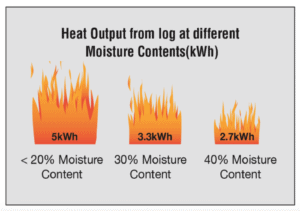Tips for Storing Logs for Your Stove
.
In the midst of an August heatwave, the thought of burning wood, using a stove or anything related to keeping warm is the very last thing on your mind. However, in three-weeks time, we will be in (meteorological) autumn. It’s autumn when we start to think about switching the heating back on. While September can be a sunny month, the days do start to become noticeably shorter and the mornings that little bit cooler.
Buy Logs or Cut and Store Logs?
Due to the energy crisis in the UK, the thought of turning the heating on for many people is a serious concern. Looking at burning wood can offer great cost savings if done right. If you wish to use your stove more in the winter or are looking at having a stove installed for the winter, you will need a good supply of logs. These logs need to be seasoned; either you can do this, or you can buy them already seasoned. The latter being more expensive.
It is advisable to store a generous supply of logs for your wood-burning stove unless you are planning to only use the stove very occasionally and are prepared to pay for logs each time you plan to use it. Some wood can take up to 2 years (such as oak) to season and so preparing logs is a long-term project which needs to be done right.
Correctly Seasoned Wood:
Using dry/seasoned wood will help ensure a better burn, fewer emissions, and a fire, which is much easier to light. Fresh wood will have a moisture content of around 50%, whereas dried/seasoned wood will have a moisture content of around 20%. Since 1st May 2021 the government has been phasing out the sale of wet/unseasoned wood in small volumes (under 2m3) in England. This is part of the successful The Ready to Burn initiative; where DEFRA appointed HETAS and Woodsure to run this certification scheme, which educates and informs consumers about the environmental dangers of burning wet/unseasoned wood, and to drive out the sale of unseasoned wood.
All logs sold in qualities under 2m3 in England must be certified as Ready to Burn.
If you burn 10kg of dry wood with a moisture content of 20% then you have evaporated 2kg of water, as opposed to unseasoned wet wood, which could have a moisture or water content of 50%, where you would have to evaporate 5kg of water. It is the wasted energy of having to evaporate the additional water that impacts a fire’s performance.

.
Where to store your firewood?
.
As a general rule, freshly cut wood should not be stored inside. However, firewood should be bought inside one day before it is to be burnt. Outdoor woodsheds are ideal for storing wood, although not all households have the space for this. If you don’t have a woodshed, then make sure where you store the wood is in a dry, well-ventilated area which is protected from dampness and rain. You should also allow air to be able to flow in, under and around the logs. Cross-stacking wood is best. Do not stack too high unless the wood is supported by a damp-free wall.
.
Car garages are not ideal for storing wood due to the fire risk. Firewood should also not be stored directly on top of the ground without supporting logs, as this can trap moisture. The key to successful storage and seasoning of logs is ensuring they are kept dry and have adequate air circulating around them.
If you are making the move to a wood-burning stove, it’s never too late to start seasoning your own wood. Starting now and gathering your own firewood means in a year or two in the future; depending on the wood you gather, will mean you will have a supply of wood to keep you warm.
For our range of wood-burning stoves, please click here.